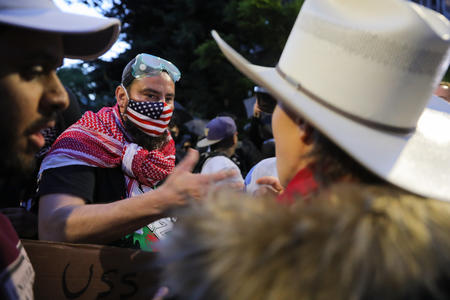A scout, buffalo hunter and soldier, his resume was more inflated than the belly of Diamond Jim Brady, the notorious Gilded Age gourmand. Bill never rode for the Pony Express nor scouted for Custer as he claimed, but his message and spectacle sold a fantasy of the American West that shaped the world’s sense of American history and spawned dozens of copycats.
And when the buffalo were gone, Buffalo Bill rode on. He toured the country and Europe. As the railroads stretched across the North American continent, he went further west, eventually to Seattle. And in Seattle he had an idea that helped his celebrity live on even further.
You associate the buffalo — the American bison — with the Great Plains, where they lived by the millions. But they also lived and grazed in the Pacific Northwest, proliferating after the glaciers melted and the megafauna vanished. They were in eastern Oregon and Washington, and many tribes here had access to them — for the Yakama, the Nez Perce, the Cayuse, the Spokane and others, they were part of their diet and culture.
Buffalo Bill made his name as a scout for the U.S. Army and as a buffalo hunter — a deadly shot who led wealthy tourists from back East on buffalo hunts at a time when one way of fighting Indigenous people of the plains was to wipe out their source of life support, the buffalo. Interest in life on the plains eventually drew Bill to New York City, where he played himself in stage and in touring dramas.
Bill decided to take his show on the road. He recruited cowboys and sharpshooters like Annie Oakley, native chiefs like Sitting Bull, Sioux dancers and white soldiers to recreate, night after night in city after city, a traveling pageant of the West. His selling point was “authenticity” — a performance that merged real frontier figures and fiction into a narrative of colonial conquest. His show was multicultural: mixed-race scouts, stunt horse men and women and rough riders from all over the world — Mexican vaqueros, Cossacks, gauchos, Arab Bedouins. Native people, often whole families, were hired to show off Indigenous ways. Yet the big white man on his white horse with his white hat presided over the mythmaking.
Buffalo Bill’s show first reached Seattle in 1908. The show set up on grounds at 29th and Jefferson — an open-air arena of tents and grandstands. It promised “a diorama of Indian warfare, a reproduction of Western life … ” There was a great train holdup; riders playing football on horseback; the Battle of Summit Springs was recreated with Bill himself playing himself killing Cheyenne Chief Tall Bull, a disputed claim. The Seattle Star reported “It was all a whirl of galloping horses, shouts in all languages from Piute to Tartar, whips crackling, lariats whirling and a big roar of applause.” It sold out.
From our perspective now, every Western cliché was showcased or invented in Wild West shows like Buffalo Bill’s, and they had a direct impact on the new medium of silent films. A good example is a Wild West show that came to town the following year, setting up on the county fairgrounds at Madison Park, across Union Bay from the 1909 Alaska-Yukon-Pacific Exposition, Seattle's first world’s fair.
A cowboy from Bill’s show who called himself Cheyenne Bill — his real name was William J. Gabriel — put on a very similar show. It featured a young up-and-coming rodeo rider, Tom Mix, who went on to stardom in the first movie Westerns that would turn the Wild West show into cinematic entertainment.
Some of the realism portrayed in Cheyenne Bill’s show might shock modern sensibilities. The closing act showcased a performer named “Reindeer Ike” who played a cattle rustler. He is lassoed, dragged across the arena behind a horse, and lynched in the grand finale — in two performances a day! “So realistic is his part of the event illustrating quick justice in the old cattle country that many of the spectators refuse to believe the apparently lifeless form hanging from the tree is really that of the man who crept up on the sleeping cowboy and stole his horse.”
While most of the Northwest was no longer the frontier, lynchings were not unknown here into the early 20th century. And in 1882, three white men, accused killers, were brutally lynched by a Seattle mob downtown intent on committing its own murders — a mob that got off scot-free.
Cheyenne Bill’s show included fake history too. It showcased a recreation of the infamous Mountain Meadow massacre in which an immigrant train crossing Utah had been slaughtered. In the show, Sioux warriors were responsible. But in reality, the slaughter was committed by a Mormon militia in white-on-white violence. Cheyenne Bill did know something about massacres: He’d been a dispatch rider for Gen. Nelson Miles during the Wounded Knee campaign.
Today, myths of the West persist. So do the buffalo, thanks largely to Indigenous people who sought to save them from extermination. Some tribes are still allowed to hunt wild buffalo by treaty rights. The Yakama nation, for example, is building a large bison herd and have made sanctioned trips to hunt buffalo in Yellowstone to keep their cultural traditions alive and feed their community.
Bill himself last performed in Seattle in 1915, and while staying at a Seattle home, his niece said, he knew the end of his touring was near. The idea of a museum was hatched because Bill wanted his legacy to live on.
For better and worse, it has.





